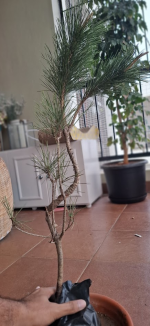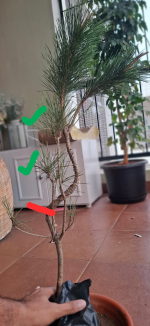souvik1811
Yamadori
Hello Bonsai gurus,
After the sad demise of my last pine (thread - https://www.bonsainut.com/threads/is-my-pine-dying.66907/), I eagerly wanted to try another one. I found an online store selling Japanese Black Pines (they are very rare here, and not available at most offline nurseries) and decided to gift myself one for my birthday. In order to save some growing seasons, I asked for a large specimen, and one with some movement in the trunk.
What I received yesterday is this!! In hindsight, I should probably have ordered a younger tree with more styling options. It would have been much cheaper also.

It seems to have been pre-wired into the more commercial S-curve shape, resulting in deep wire scars. The bend is too high up on the trunk to my taste. There is little to no taper. In fact, the wire constriction in the S-curve portion seems to have fattened that part up rather than the base of the trunk, resulting in some inverse taper as well. There are three branches way up on the top which seem to be vigorous, but the branches at the bottom are very sparse or with no needles at all. I am at a total loss for design options. I have been considering the following options, but any advice would be really helpful and appreciated.
1. Cut off the top with the curve: In this scenario, I would remove the top as highlighted in red, and let the branches highlighted in green become new leaders. Hopefully, with heavy fertilization, it would then back-bud and give more shoots after the cut. They say that a pine's energy is in the roots and not in the foliage, so I am hoping the tree can recover from such large foliage removal.

However, I would prefer to re-use the top and I was wondering if I could air layer it to have the curve starting close to the root base. I have air-layered ficuses before, but I have read that it can be very difficult on JBPs. If the air layer takes moths to root, should I have to thin out the top foliage to balance the energy - Or else do I risk losing the bottom branches in the meantime?
2. Keep only the top foliage and style it into a literati: In this scenario, I might not need to need to thin out the foliage on the top, as the three branches on the top are more or less equal in foliage mass. And I could just remove/jin the bottom branches. But I am wondering if it would be possible to bend this thick trunk into something aesthetic. I might have to source some rafia in that case? What do I do about the inverse taper?
Any other suggestions would also be welcome. Or do you think it is really hopeless material, and should probably be planted in the ground and forgotten about?
After the sad demise of my last pine (thread - https://www.bonsainut.com/threads/is-my-pine-dying.66907/), I eagerly wanted to try another one. I found an online store selling Japanese Black Pines (they are very rare here, and not available at most offline nurseries) and decided to gift myself one for my birthday. In order to save some growing seasons, I asked for a large specimen, and one with some movement in the trunk.
What I received yesterday is this!! In hindsight, I should probably have ordered a younger tree with more styling options. It would have been much cheaper also.

It seems to have been pre-wired into the more commercial S-curve shape, resulting in deep wire scars. The bend is too high up on the trunk to my taste. There is little to no taper. In fact, the wire constriction in the S-curve portion seems to have fattened that part up rather than the base of the trunk, resulting in some inverse taper as well. There are three branches way up on the top which seem to be vigorous, but the branches at the bottom are very sparse or with no needles at all. I am at a total loss for design options. I have been considering the following options, but any advice would be really helpful and appreciated.
1. Cut off the top with the curve: In this scenario, I would remove the top as highlighted in red, and let the branches highlighted in green become new leaders. Hopefully, with heavy fertilization, it would then back-bud and give more shoots after the cut. They say that a pine's energy is in the roots and not in the foliage, so I am hoping the tree can recover from such large foliage removal.

However, I would prefer to re-use the top and I was wondering if I could air layer it to have the curve starting close to the root base. I have air-layered ficuses before, but I have read that it can be very difficult on JBPs. If the air layer takes moths to root, should I have to thin out the top foliage to balance the energy - Or else do I risk losing the bottom branches in the meantime?
2. Keep only the top foliage and style it into a literati: In this scenario, I might not need to need to thin out the foliage on the top, as the three branches on the top are more or less equal in foliage mass. And I could just remove/jin the bottom branches. But I am wondering if it would be possible to bend this thick trunk into something aesthetic. I might have to source some rafia in that case? What do I do about the inverse taper?
Any other suggestions would also be welcome. Or do you think it is really hopeless material, and should probably be planted in the ground and forgotten about?

